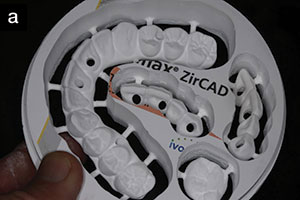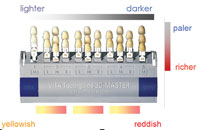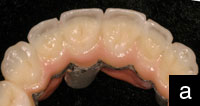One of the most critical decisions that we make as practitioners is choosing our dental laboratory partner(s). It has far-reaching financial and emotional consequences for our practices and our patients. Nearly 38% of the average general practice’s revenues come from fixed crown and bridge work. According to a recent survey, dentists rank quality and consistency as the most important factors that they look for when selecting a dental laboratory. Good communication, the laboratory’s reputation, and turn-around time also rank high among the factors they desire in a laboratory. According to the same survey, 64.5% use 2 to 3 fixed indirect laboratories, and approximately 33% of dentists say they have changed laboratories in the past 2 years, with the majority stating that inconsistency was the reason for their need to switch.1
We know from this and other surveys that there is room for improvement. As doctors, we must assess and improve the communication, relationship, and technical skills needed to achieve the desired outcomes with our laboratory team members. We also need to examine the communication and leadership skills involved in our selection process of a quality dental laboratory. This article will discuss some of the issues and dilemmas we face in making our choices.
BEGIN WITH REALISTIC EXPECTATIONS
Long-lasting relationships, whether personal or professional, begin with honesty. Our practice and laboratory team should hold perfection up as the goal. However, the quality and consistency that so many of us are expecting can be a challenge to obtain. We know that the difficult and sometimes changing circumstances found in the actual execution and delivery of patient care often compromise perfection. Like it or not, that is the reality we face. Despite this, with a solid doctor/technician relationship, predictable and quality results are usually achievable.
IS MY PRACTICE COMPATIBLE WITH THE LABORATORY UNDER CONSIDERATION?
Before beginning the search for the optimal dental laboratory, we need to examine our own practices. Have we articulated our business vision and treatment philosophy? Are we willing to pay for the quality that we profess to be seeking, just as we most likely expect our patients to do? These are the first questions that must be answered before beginning our search for the right laboratory. Once we have determined our own vision and practice goals, it is a lot easier to determine if we are, in fact, compatible with the prospective laboratory.
Stress, distrust, and inconsistency enter into any relationship that involves incongruent visions. Look first for a dental laboratory that reflects your vision, business, and treatment philosophies. Is your laboratory product-production or doctor-patient-product-service centered? Look for a laboratory that delivers true value for the prices they charge. In addition to a quality, consistent product, do they offer technical support? On-time service? Open communication and technical feedback? Is continuing education a priority for both the employees and doctors they serve?
QUALITY WITH CONSISTENCY OR HIGH PRODUCTION WITH LOW FEES?
A practice that is heavily insurance-based and operates on a fee-for-commodity philosophy is not compatible with a quality, fee-for-service-based dental laboratory. The converse is true as well. Laboratory owners and doctors alike are faced with the same quantity-versus-quality dilemma. Furthermore, dental technicians know the law of diminishing returns just as we do. The more they are pushed in high-production laboratories, the higher the stress and the more numerous the technical problems can become. The temptation to just “let it go” quickly takes over. The internal (in-lab) and external (doctor) remakes dramatically increase. Training and continuing education are often overlooked, and employee morale decreases. Not only is quality reduced, consistency and scheduling become an insurmountable challenge. As a result of a high-production business philosophy, doctors come and go, giving the laboratory sales force job security as they struggle constantly to find and retain new clients. In addition, lower fees must always accompany this work ethic. This is because the doctor buying the product may be making the decision to buy primarily based on fees and not on quality, consistency, service, and support. It is a revolving door approach that results in unbelievable stress and eventual burnout for all.
What’s the solution? At the end of the day we must be willing to pay for the level of quality, consistency, and service that we desire. It is advantageous to have an understanding of the interbusiness fee relationships. It may require caution when the occasional financial consul-tant too quickly suggests that you find another laboratory without understanding the full consequences on chair time, stress, relationships, referrals, practice image, and the profits that they are professing to improve. In the long run, this could sometimes prove to be a “penny-wise but pound foolish” ap-proach.
VISITING THE PROSPECTIVE DENTAL LABORATORY
We need to take the time to get to know one another before making the final decision to commit to a long-term relationship. It requires a decision based on far more information than that received via direct mailings, journal advertisements, or sales calls squeezed into a busy day treating patients!
The best way to evaluate any dental laboratory is to visit it on a workday to meet and observe the dental technicians in action. Here are some of the things to look for:
 |
 |
| Figure 1. A strong visual impact can be made on visitors by what is first seen upon entering the dental laboratory. | Figure 2. The dental laboratory reception area should be comfortable and professional for guests and visitors. |
(1) Appearance and cleanliness (inside and outside) of the laboratory. Does the overall appearance and decor complement your type and style of dental practice? Does the laboratory have a reception area with a staff member dedicated to greeting visitors (Figures 1 and 2)? Is there adequate and convenient parking for visitors?
(2) Would you feel comfortable sending your pa-tients there for a custom shade or tour of the facility?
(3) What is the overall “feel” of the laboratory? Stressful? Friendly? Hectic? Relaxed? Professional?
(4) Are the technicians professional and courteous as you are introduced to them? Are they dressed in professional attire appropriate for their job?
 |
 |
| Figures 3 and 4. Observe the level of cleanliness and organization of the work spaces. Are the dental technicians professional in demeanor and appearance? Is magnification appropriate for the task being utilized? |
(5) Observe the manner in which the individual technicians are working and communicating. Are their benches neat and well organized? Are they using magnification when appropriate (Figures 3 and 4)?
(6) Are the case pans clean, organized, and fitted to the size/type of the cases?
(7) Does the laboratory have most or all of the different types of restoration production capability that you require? Are there any future plans to add to the restoration selection?
(8) How does the laboratory choose new materials for its doctors? Do the dental technicians get thorough train-ing in the material before it is introduced? Does the laboratory involve any of its doctors in the decision process?
(9) Ask permission to randomly choose and examine at least a dozen cases in various stages of completion. Try to select different types of restorations. Take your time with this step in the laboratory evaluation process. How are larger cases being handled? Bite registrations? Articulators? Occlusion? Does the laboratory schedule and track the progress of its cases? Observe not only the quality of the work but also the quality of the impressions and preparations coming in from existing doctors. Are the technicians completing work on cases that should have been called on or even returned for a re-prep or another impression? This will tell you a lot about the laboratory’s business philosophy and approach to service/technical assistance. It can give you a feel for how effectively the technicians are communicating with their doctors.
Interviewing the Laboratory Owner
You will need to spend some time talking with the laboratory owner. To get off on the right foot, both of you must give priority and energy to making the meeting a success. To set the stage for meaningful dialogue it is always best to schedule this time outside of the laboratory or practice facility. This will allow for an uninterrupted meeting and give both parties a chance to speak candidly and privately about any issues of concern. Allow at least 90 minutes for this important meeting. An early breakfast meeting before the start of the day is often preferable. It should not be scheduled at the lunch hour squeezed in the middle of a busy workday. The chance of being late or having the pressure to return to the office in time for an afternoon patient can stifle this crucial event.
Why Meet? Just Give Us Some Boxes and Script
Let the laboratory owner know that getting to know each other is the first and primary objective of this meeting. Many times as dentists we fail to see the importance of taking the time to establish an exceptional inter-personal relationship. This is also true for the laboratory who will often rush to take cases from doctors they do not know. If we first take the time to establish a close, personal working rapport, then trust and meaningful communication will follow.
You should agree, as a ground rule for this meeting, that any decision to work together is a 2-way process. Each party must believe that he or she has each other’s best interests in mind. It must also be understood that it is not necessary to come to a final decision at this first meeting. You may have to meet more than once before both of you feel like you have established the right foundation on which to build a superior business relationship.
OK, What Should We Talk About First”Aluminum Oxide Copings or Indirect Composites?
Another important ground rule is that this introductory meeting should not gravitate toward a discussion of techniques and materials. This can be a challenge for the technically oriented minds involved, but realize that there will be plenty of time later for these discussions. This is the time for gathering information regarding compatibility between the 2 businesses and for beginning to explore the possibility of a professional relationship.
The following are suggested topics to cover. They will help each party rapidly discern whether or not he or she will be able to partner up to produce some exceptional work. Remember, the outcome of this meeting will have a major impact on the overall success of the relationship, the longevity of the relationship, the profits enjoyed, and the level of stress in accomplishing the future tasks at hand.
(1) Begin the meeting with some personal information”an introduction of who each person is and where each person has been in life. Education? Employment? Family life? Hobbies or interests?
(2) Share your own vision and business philosophy.
(3) Ask the laboratory owner what the vision is for his or her dental laboratory business. If the owner has not developed this aspect of life and business, he or she might feel a bit uncomfortable and unprepared. Be careful not to push or embarrass the owner with this topic. On the other hand, if he or she has developed and lives by a vision, it will be evident. This is exactly what you want to know.
(4) Share your educational goals and how they fit into your overall vision. Discuss (generally for now) how you might work together in this area. Ask if there is openness to the option of a coordinated continuing education schedule that would involve the entire doctor/staff and laboratory owner/staff teams in the development of relationship, communication, business, and technical skills.
(5) What are the laboratory’s continuing education goals and priorities?
Ask the laboratory owner what his or her ideal client would be like. (Pay close attention to references to personality traits, emotions, type of work, practice style, etc). If he or she could wave a magic wand and make changes to improve the quality of laboratory work, decrease stress, reduce remakes, and increase profits, what would they be? (Listen.)
(6) Re-cap and discuss what you have in common in all of the above. Briefly note any significant differences. This is the “meat” of the meeting that will be crucial to your joint decisions.
(7) Before leaving, ask if the owner has any other questions or concerns about you that have not been covered. Set up a definite time to get back together by phone to discuss each other’s feelings about proceeding with a new business relationship.
Decision Time Has Arrived!
At this point, if you have managed to do all the above things to gather information about your potential laboratory partner, you have done far more than 95% of your peers in dentistry! (Only a small minority have ever visited their existing or prospective laboratories for any meaningful length of time. Even fewer dental office staff team members have visited their dental laboratories.) You should now be armed with lots of relevant facts and feelings. You will have the confidence in knowing whether your future team member shares your business vision and philosophy. This will help you make a well-informed decision. Of course, if you do not come to a mutual agreement at this point, then you are back to the drawing board. However, the time spent on this process is not time lost. You will have become more adept at the 2-way interview process, and your next laboratory interview will be even easier. If the decision is positive for the new business relationship, and your laboratory colleague comes to the same conclusion, then you have most likely selected the right laboratory for your practice!
CONCLUSION
It is a given that the vast majority of us want the very best for our patients. We are often preoccupied acquiring the technical skills to achieve our self-improvement goals. However, to realize our full and complete potential, the ability to find and forge a long-term relationship with a like-minded laboratory is essential. Now more than ever we need leadership and communication skills to choose, nourish, and sustain an exceptional laboratory relationship. Through further study, mentoring, and learning from side-by-side experiences with our dental laboratory partners, each and every one of us can fulfill our dreams. We have the possibility and power to create a practice that fills our hearts with fond memories of meaningful professional relationships and teamwork that truly makes a difference in the lives of our patients!
Reference
1. Dental Products Report 2003 Communications Survey, mailed December 2004.
Dr. Adams is an assistant clinical professor at Medical College of Ohio, Division of Dentistry, Department of Otolaryngology, in Toledo, Ohio. He lectures both nationally and internationally for many dental organizations and dental laboratories. In addition to his years in private practice, he has had the opportunity to serve as the doctor/technician liaison for a high-end commercial dental laboratory for 10 years. This unique combination of experiences has enabled Dr. Adams to bring clinically relevant discussions and practical solutions to the challenges facing the entire dental team. He has written numerous articles on clinical, laboratory, insurance, and marketing topics, and is currently listed in Dentistry Today’s Leaders in Continuing Education for 2005. Dr. Adams is a member of the ADA, MDA, AGD, AACD, and ICOI, and is a fellow of the International College of Dentists. He can be reached at (231) 946-8880 or damona11@ hotmail.com.
Disclosure: Dr. Adams is currently employed by National Dentex Corporation and is a consultant and doctor/technician liaison for DH Baker Dental Laboratory in Traverse City, Mich.
To comment on this article, visit the discussion board at dentistrytoday.com.











